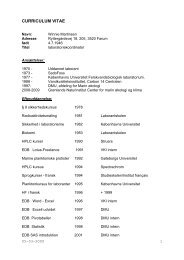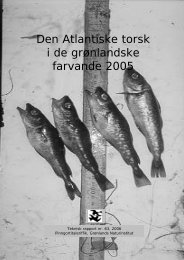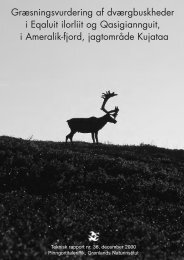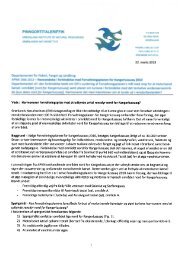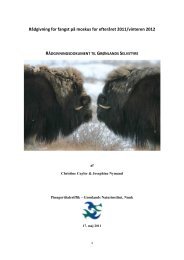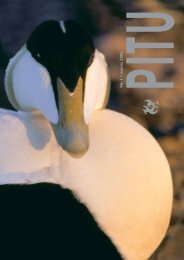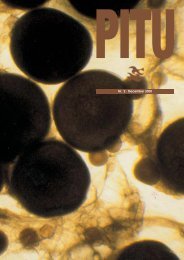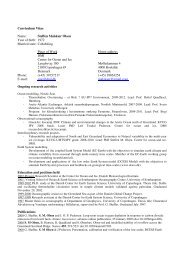Migration and breeding biology of Arctic terns in Greenland
Migration and breeding biology of Arctic terns in Greenland
Migration and breeding biology of Arctic terns in Greenland
You also want an ePaper? Increase the reach of your titles
YUMPU automatically turns print PDFs into web optimized ePapers that Google loves.
20<br />
Renest<strong>in</strong>g <strong>in</strong> <strong>Arctic</strong> <strong>terns</strong> was an important component <strong>in</strong> the fi eldwork at<br />
Kitsissunnguit (Manus II <strong>and</strong> III). By experimentally remov<strong>in</strong>g eggs <strong>and</strong><br />
monitor<strong>in</strong>g the response <strong>of</strong> the <strong>breed<strong>in</strong>g</strong> birds, the fi rst estimates <strong>of</strong> relay<strong>in</strong>g<br />
rate, <strong>and</strong> chick growth <strong>and</strong> survival rates were obta<strong>in</strong>ed for <strong>Arctic</strong> <strong>terns</strong><br />
(Manus III). However, this challenge was not without large logistical diffi<br />
culties. The lay<strong>in</strong>g date <strong>in</strong> <strong>Arctic</strong> <strong>terns</strong> <strong>breed<strong>in</strong>g</strong> <strong>in</strong> Disko Bay varied (see<br />
section “Variation <strong>in</strong> <strong>breed<strong>in</strong>g</strong> phenology”) by as much as three weeks,<br />
mak<strong>in</strong>g the onset <strong>of</strong> fi eldwork diffi cult to plan. If <strong>breed<strong>in</strong>g</strong> <strong>terns</strong> were to<br />
be followed from early <strong>in</strong>cubation, <strong>and</strong> egg removal experiments allow<strong>in</strong>g<br />
the birds to mate, egg formation to take place, an <strong>in</strong>cubation period <strong>of</strong> 22<br />
days, <strong>and</strong> chicks were to be followed until fl edg<strong>in</strong>g, the fi eld season had<br />
to be <strong>of</strong> two to three months <strong>in</strong> duration. In practice, the dem<strong>and</strong>s <strong>of</strong> such<br />
a long fi eld period proved diffi cult to meet, <strong>and</strong> not all aspects <strong>of</strong> renest<strong>in</strong>g<br />
<strong>in</strong> <strong>Arctic</strong> <strong>terns</strong> could be covered with<strong>in</strong> the framework <strong>of</strong> this research.<br />
Despite the fact that eggs were removed <strong>in</strong> the latter half <strong>of</strong> <strong>in</strong>cubation,<br />
<strong>and</strong> past the 10 day period suggested by Bianki (1967), at least 16 out <strong>of</strong> 30<br />
<strong>breed<strong>in</strong>g</strong> pairs (53.3%) at Kitsissunnguit produced a replacement clutch<br />
(Manus III). The clutch size (1.6) at these nests was signifi cantly lower<br />
than <strong>in</strong> control nests (2.1), as was the total Internal Egg Volume (IEV).<br />
None <strong>of</strong> the replacement eggs were relayed <strong>in</strong> the orig<strong>in</strong>al nest cup, but<br />
were <strong>in</strong>stead placed <strong>in</strong> a new nest at an average distance <strong>of</strong> 23.4 meters<br />
from the orig<strong>in</strong>al nest cup.<br />
The results from Kitsissunnguit verify the general perception that <strong>Arctic</strong><br />
<strong>terns</strong> do produce a replacement clutch – even if the eggs are removed<br />
relatively late <strong>in</strong> the <strong>breed<strong>in</strong>g</strong> season. Although the long term impact <strong>of</strong><br />
relay<strong>in</strong>g, such as the post-fl edg<strong>in</strong>g survival <strong>of</strong> chicks, <strong>and</strong> the extra energy<br />
expenditure required <strong>of</strong> adult females, are not accounted for <strong>in</strong> this study,<br />
it does <strong>in</strong>dicate that the birds are cable <strong>of</strong> compensat<strong>in</strong>g for the loss <strong>of</strong><br />
eggs to some extent. The fi nd<strong>in</strong>gs <strong>in</strong> Manus III, where chicks from replacement<br />
clutches did not differ <strong>in</strong> their growth <strong>and</strong> survival (at least to eleven<br />
days), further support this conclusion.<br />
1.9 Variation <strong>in</strong> <strong>breed<strong>in</strong>g</strong> phenology<br />
The fi eldwork at Kitsissunnguit <strong>and</strong> at S<strong>and</strong> Isl<strong>and</strong> also revealed that<br />
<strong>breed<strong>in</strong>g</strong> phenology may vary considerably between years, with considerable<br />
variation <strong>in</strong> egg lay<strong>in</strong>g between <strong>breed<strong>in</strong>g</strong> seasons, as also seen <strong>in</strong><br />
<strong>Arctic</strong> <strong>terns</strong> <strong>in</strong> Shetl<strong>and</strong> (Suddaby <strong>and</strong> Ratcliffe 1997). At Kitsissunnguit,<br />
the majority <strong>of</strong> eggs hatched <strong>in</strong> the fi rst week <strong>of</strong> July (<strong>in</strong>dicat<strong>in</strong>g that egg<br />
lay<strong>in</strong>g took place <strong>in</strong> mid-June), but <strong>in</strong> some years early <strong>breed<strong>in</strong>g</strong> takes<br />
place – as was the case <strong>in</strong> 2004, where eggs hatched three weeks earlier<br />
<strong>in</strong> mid June (Egevang et al. 2005). At S<strong>and</strong> Isl<strong>and</strong>, hatch<strong>in</strong>g took place approximately<br />
two weeks earlier <strong>in</strong> 2008 than <strong>in</strong> 2007, with a broader distribution<br />
<strong>of</strong> hatch<strong>in</strong>g dates observed (Egevang et al. 2008, Egevang <strong>and</strong><br />
Stenhouse 2007).<br />
The onset <strong>of</strong> egg lay<strong>in</strong>g is likely correlated with sea ice conditions <strong>in</strong> <strong>Arctic</strong><br />
regions (Hatch 2002) <strong>and</strong> this may expla<strong>in</strong> the observed variation <strong>in</strong> this<br />
study. The variation <strong>of</strong> up to three weeks difference <strong>in</strong> egg lay<strong>in</strong>g may<br />
have implications for population monitor<strong>in</strong>g at <strong>Arctic</strong> tern colonies. If<br />
pair formation is not completed, fl ush count estimates will underestimate<br />
population numbers. In l<strong>in</strong>e transect estimates (Manus IV), both the count





